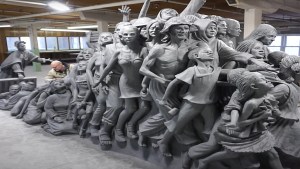Canadian sculptor Timothy Schmalz, who gave the world a new perspective on the migrant crisis with his stunning 20-foot bronze sculpture “Angels Unawares” in 2019, is back with a new important work of art. Called “Let the Oppressed Go Free,” the new sculpture is another 20-foot work that brings the plight of modern day slavery to the forefront. The work will soon be displayed in Dublin, Ireland, for St. Patrick’s Day.
The new sculpture is just as massive in scope as the 2019 piece. “Let the Oppressed Go Free” depicts St. Josephine Bakhita, the patron saint of human trafficking survivors, lifting the gates of the underworld in order to free the victims of human trafficking. From the small hole in the ground some 50 figures arise, dressed in outfits from various points in history.
Bakhita, who was born in Darfur in the 19th century, was abducted as a child and spent the majority of her early life enslaved. That a freed slave from the previous century is the impetus for the release of modern day slaves is an important element of the piece, to which Schmalz is fast to draw attention.
Our neighbors
Schmalz told Global Sisters Report that he designed the figures to give an accurate representation of what human trafficking looks like. He noted that major media sources tend to focus on victims of child sex trafficking, but people from all walks of life can fall victim to such crimes.
The figures include a child bride, those forced into labor, young beggars, and even an individual who has had organs removed. According to CNA, Schmalz added an infant to the project at the request of Sister Gabriella Bottani. She brought his attention to the illegal practice of selling infants on the black market. Schmalz said of human trafficking:
“Most human trafficking victims are not these alleged models or prostitutes that are depicted with their hands tied up,” he said. Instead, he added, they are often the men and women next door.
Sister sculpture
One reason the new sculpture’s size matches his 2019 work is because “Let the Oppressed Go Free” is a response to “Angels Unawares.” In his announcement video, Schmalz explains that the idea of “Let the Oppressed Go Free” was initially conceived by Cardinal Michael F. Czerny, who suggested it to Schmalz after “Angels Unawares” was installed in the Vatican. The prelate wanted Schmalz to use his talents to bring attention to human trafficking in the same way.
Schmalz noted:
“As the Cardinal said, ‘If we don’t take care of the people on the boat on my one sculpture, they’ll end up on my new sculpture.’”
An inconvenient truth
Another reason the sculpture is so large, Schmalz said, is that it is meant to be an imposition. A sculpture that big is no mere obstacle to be walked around, but rather a monument that demands one’s attention. The artist explained:
“I really do believe that the first part of stopping human trafficking is to get people aware of it. This sculpture, 20 feet, installed in major cities is going to be an inconvenience. It’s meant to be on a pathway or a sidewalk and it’s meant to disrupt our day to day life visually. The message is very strong. I believe that we need to use as many weapons or tools as possible to stop using human trafficking. I do believe that art is a magnificent tool for this.”
Installation in Dublin
This week, Schmalz is in Dublin, Ireland, where “Let the Oppressed Go Free” will be unveiled and blessed on St. Patrick’s Day. The date is significant for the subject of the exhibit, as St. Patrick himself was a victim of human trafficking in the 5th century.
The day is expected to bring reflections from Irish President Michael D. Higgins and Archbishop Dermot Farrel on the thousands of women, children, and men who are trafficked through Europe each day.
In a press release, Schmalz said of the Dublin unveiling:
“The purpose of both these sculptures is to draw attention to refugees and human trafficking and see both issues within a spiritual perspective. To have one of the original models presented in Ireland on St. Patrick’s day harnesses the power of Ireland’s greatest saint for this much needed awareness.”

